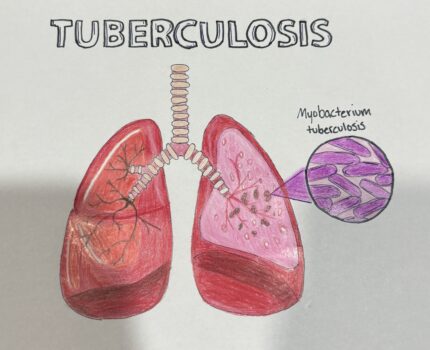In my project, I chose to research tuberculosis because I wanted to know why my father tests positive for tuberculosis even though he doesn’t actively have it. Tuberculosis is an important disease to research because it is a deadly pandemic and one of the top leading causes of deaths in the world. In my image, The right lung is healthy and the left lung is contaminated with mycobacterium tuberculosis. I wanted to convey the granules caused by fibrosis and the necrosis which are the dark spots in the lungs. The bronchi on the left lung is inflamed and darker. The bronchioles are also a lighter color to show that tuberculosis damages bronchioles as well as the lungs. The small circular image is a microscopic drawing of what the bacterium looks like.
Tuberculosis is caused by a bacterium called mycobacterium tuberculosis. This disease can attack many parts of the body including the brain, however, it most commonly attacks the lungs. Tuberculosis is contracted by person to person contact through air particles such as sneezing and coughing. These contaminated particles find their way inside the lungs where they attack lung tissue. This impacts gas exchange by damaging the alveoli, causing more problems from the lack of oxygen in the tissues. When the disease is contracted, it causes symptoms such as fatigue, sputum, difficulty breathing, fever, and more. The excess sputum is from the body producing more sputum to fight off the bacterium and the fatigue comes from the lack of oxygen. When the alveoli sacs are damaged this causes the walls between the sacs to tear, making larger air pockets that interferes with the partial pressure in gas exchange, meaning there is more carbon dioxide than oxygen. Tuberculosis also orchestrates inflammation, fibrosis, necrosis, and more. Inflammation closes the bronchioles making less oxygen get to the lungs, fibrosis thickens the lung tissue, while necrosis is the tissue death that causes the “cheese-like” holes or granulomas. There are many options to test for this disease such as a blood test, a skin test, sputum culture, and a chest x-ray. The skin test is also known as the Mantoux test, this is when a protein derivative is put in the epidermis with a syringe to make a fluid pocket. If the skin becomes inflamed and red it is a positive marker. Commonly, there is a false positive for the tuberculosis skin test. This is because there are two types of tuberculosis; active and latent. When a person has latent tuberculosis, they have been previously exposed to the disease. The reason it is latent is because the macrophages in the body reacted quickly and consumed the tuberculosis bacterium leaving it dormant inside the macrophages. A person with latent Tuberculosis will also have a positive blood test however, when taking a follow up x-ray or sputum culture, it will be negative. Unfortunately, there is no vaccine for tuberculosis however there is a treatment. A drug cocktail of isoniazid, rifampicin, pyrazinamide, and ethambutol which are antibiotics and antimicrobial medications. The treatment is divided into two phases; 2 months of the 4 medications and afterwards 4 months of isoniazid and rifampicin to kill off all latent tuberculosis bacteria. This treatment was discovered 60 years ago and has not changed since. When treatment has finished there will still be lifelong lung damage and scarring that can cause symptoms such as shortness of breath.
Sources:
Wang, C., et al. “Pulmonary Tuberculosis Biomarker Mir-215-5p Inhibits Autophagosome-Lysosome Fusion in Macrophages.” Tuberculosis, Churchill Livingstone, 17 Oct. 2023, www.sciencedirect.com/science/article/abs/pii/S1472979223001208.
Shah, Maunank, and Susan Dorman. “Latent Tuberculosis Infection | NEJM.” Latent Tuberculosis Infection, New England Journal of Medicine , 8 Dec. 2021, www.nejm.org/doi/full/10.1056/NEJMcp2108501. Alsayed, Shahinda S R, and Hendra Gunosewoyo. “Tuberculosis: Pathogenesis, Current Treatment
Regimens and New Drug Targets.” International Journal of Molecular Sciences, U.S. National Library of Medicine, 8 Mar. 2023, www.ncbi.nlm.nih.gov/pmc/articles/PMC10049048/.

